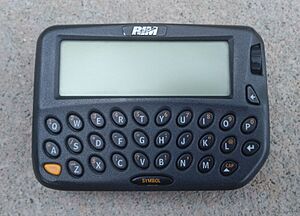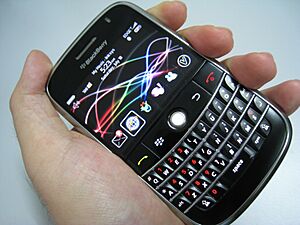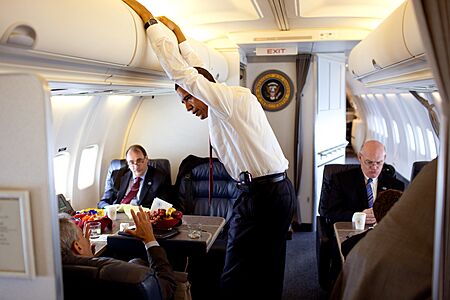BlackBerry facts for kids

Final logo introduced in 2004
|
|

BlackBerry Bold 9700 (2009)
|
|
| Developer | BlackBerry Limited (1999–2016) BB Merah Putih (Indonesia; 2016–2019) Optiemus Infracom (India; 2017–2018) TCL Corporation (Worldwide; 2016–2020) |
|---|---|
| Manufacturer | Optiemus Infracom (South Asia) FIH Mobile (Enterprise) BlackBerry Limited TCL (Worldwide) BB Merah Putih (Indonesia) |
| Type | Handheld devices |
| Release date | January 19, 1999 |
| Discontinued | August 30, 2020 (final hardware production) January 4, 2022 (end of web services) |
| Operating system | BlackBerry OS BlackBerry 10 Android |
| Online services | BlackBerry World, Google Play Store, BlackBerry Messenger |
BlackBerry was a popular brand of mobile devices and related services. It was first created by a Canadian company called Research In Motion (RIM).
The very first BlackBerry device came out in 1999. It was like a pager but could also send and receive email messages wirelessly. People loved it because it was "always on" and made it easy to communicate. BlackBerry was one of the first to offer "push notifications" (messages that pop up instantly). It also made "thumb typing" popular using its special QWERTY keyboard.
BlackBerry devices were especially useful for businesses and people who needed to stay connected for work. In 2002, RIM released its first BlackBerry cell phone, the BlackBerry 5810. This phone could connect to the internet and send emails. BlackBerry also became known for its secure communication features.
Later, with devices like the BlackBerry Pearl (2006) and BlackBerry Messenger (BBM), BlackBerry started to become popular with everyday people, not just businesses. For a while, it was a top smartphone brand in the US. In 2011, BlackBerry had 85 million users around the world!
However, over time, BlackBerry faced strong competition from phones using Android and iOS (Apple's operating system). Its number of users dropped. In 2013, BlackBerry introduced a new operating system called BlackBerry 10. Then, in 2015, they started making BlackBerry phones that ran on Android.
By 2016, BlackBerry Limited decided to stop designing its own phones. Instead, they let other companies make and sell BlackBerry-branded devices under a special agreement. New BlackBerry phones were last made in 2020. On January 4, 2022, BlackBerry Limited stopped supporting its older software services, like BlackBerry Messenger for non-Android phones.
Contents
History of BlackBerry Devices

The company that created BlackBerry, Research in Motion (RIM), started in Canada. Their first device was the Inter@ctive Pager 900, released in 1996. It was a clamshell device that allowed two-way messaging.
The first device to be called "BlackBerry" was the BlackBerry 850, an email pager, released in 1999. The name "BlackBerry" was chosen because the tiny buttons on the keyboard looked like the small parts of a blackberry fruit. This name also suggested how fast the email system worked.
Early BlackBerry devices used special wireless networks. In 2002, the BlackBerry 5810 smartphone came out. This phone combined many features like email, phone calls, text messages, and web browsing. BlackBerry became very popular by focusing on email. They even offered their email service on other phone brands using special software.
Older BlackBerry devices had black and white screens, but newer models came with color displays. Many BlackBerry phones were designed for "thumbing," meaning you could type easily using only your thumbs. Early models used a scroll wheel for navigation, which was later replaced by a trackball, and then by an optical trackpad. Some models also had a push-to-talk feature, like a two-way radio.
On January 30, 2013, BlackBerry launched the Z10 and Q10 smartphones. The Z10 was all touchscreen, while the Q10 had a physical QWERTY keyboard combined with a touchscreen.
In March 2013, BlackBerry signed a big contract to provide secure communication for the German government.
By 2013, BlackBerry faced tough competition from other smartphone brands. On August 12, 2013, BlackBerry announced it was looking to sell the company because of its financial challenges. They also reduced their staff and product line. In November 2013, John S. Chen became the new CEO.
BlackBerry continued to secure contracts, like one for BlackBerry Z10 phones for Peugeot SA in December 2013, and a mobility management suite for Airbus in February 2014.
In July 2014, BlackBerry introduced the BlackBerry Passport, a unique phone with a square screen. It was designed for professionals in fields like healthcare. In December 2014, the BlackBerry Classic was released, which looked more like older BlackBerry phones with its classic keyboard. It was the last BlackBerry with a keyboard that covered most of the front of the phone.
In September 2015, BlackBerry unveiled the BlackBerry Priv. This was a slider phone that ran on the Android operating system, but it included extra security features inspired by BlackBerry's own systems.
In 2016, BlackBerry released the BlackBerry DTEK50, an Android phone with a focus on security. It was actually a re-branded version of another phone, but with BlackBerry's security software. Later that year, the BlackBerry DTEK60 was released, also an Android phone made by a partner company.
BlackBerry also started working with car companies like Ford Motor Company of Canada and Jaguar Land Rover to develop software for their connected vehicles.
In 2017 and 2018, new BlackBerry phones like the BlackBerry KeyOne, BlackBerry Motion, and BlackBerry Key2 were launched by partner companies. These phones often combined a physical keyboard with the Android operating system.
By 2019, some of the licensing agreements for BlackBerry phones began to fade. On January 4, 2022, BlackBerry Limited officially stopped supporting its older, non-Android BlackBerry devices and services. In October 2023, John Chen, the CEO, left the company.
Legal Challenges
BlackBerry faced several legal challenges related to its technology.
Patent Disputes
In the early 2000s, a company called NTP claimed that BlackBerry was using its wireless email patents without permission. This led to a big lawsuit. The court initially ruled against BlackBerry, which could have stopped BlackBerry services in the US. However, BlackBerry appealed, and the US government even got involved, saying that BlackBerry was important for national security.
In March 2006, BlackBerry and NTP reached an agreement. BlackBerry paid NTP $612.5 million to settle all claims, meaning they didn't have to pay ongoing fees for the technology.
Later, in 2017, BlackBerry also settled a dispute with Qualcomm, another technology company, involving a payment of $940 million to BlackBerry.
In 2020, a new company tried to bring back a 5G BlackBerry smartphone, but this plan did not move forward, and the company closed in 2022.
Other Legal Cases
BlackBerry also had legal disagreements with other companies. In 2010, they had a dispute with Kik Messenger, which was later settled. In 2018, BlackBerry filed legal action against Facebook over intellectual property claims related to Facebook Messenger, WhatsApp, and Instagram. This case was settled in January 2021.
Service Interruptions
BlackBerry services sometimes experienced outages, which meant users couldn't access their emails or messages.
In 2011, there was a major multi-day outage that affected millions of BlackBerry users in Europe, the Middle East, Africa, and North America. Research In Motion said it was caused by too much data and problems with their data centers. This outage led to calls for changes in the company's leadership.
Where BlackBerry Phones Were Sold
BlackBerry had many retail stores outside North America, including in Thailand, Indonesia, and the United Arab Emirates. In the US, a BlackBerry Store opened in Farmington Hills, Michigan, in 2007. This store sold BlackBerry devices from major US phone companies. There were also pop-up stores, like one in Frankfurt, Germany, in 2015.
BlackBerry Certifications
BlackBerry offered different certifications for people who wanted to become experts in using and supporting BlackBerry devices. These certifications helped professionals understand the devices, software, and how to provide technical help.
Some of these certifications included:
- BCESA (BlackBerry Certified Enterprise Sales Associate)
- BCTA (BlackBerry Certified Technical Associate)
- BlackBerry Certified Support Associate T2
- BlackBerry Certified Enterprise Server Consultant (BCESC)
- BlackBerry Certified Server Support Technician (BCSST)
- BlackBerry Certified Support Technician (BCSTR)
BlackBerry Products
BlackBerry made many different devices over the years.
Android-Based Devices
- BlackBerry Evolve X (2018)
- BlackBerry Evolve (2018)
- BlackBerry Key2 (2018)
- BlackBerry Motion (2017)
- BlackBerry Aurora (2017)
- BlackBerry KeyOne (2017)
- BlackBerry DTEK60 (2016)
- BlackBerry DTEK50 (2016)
- BlackBerry Priv (2015)
BlackBerry 10 Devices
- BlackBerry Leap (2015)
- BlackBerry Classic (2014)
- BlackBerry Passport (2014)
- BlackBerry Porsche Design P'9983 (2014)
- BlackBerry Z3 (2014)
- BlackBerry Z30 (2013)
- BlackBerry Porsche Design P'9982 (2013)
- BlackBerry Q10 (2013)
- BlackBerry Z10 (2013)
- BlackBerry Q5 (2013)
Older BlackBerry OS Devices
BlackBerry also had many phones running on its older operating systems, BlackBerry 7, 6, 5, 4, 3, 2, and 1. These included various models from the Bold, Torch, Curve, Pearl, Storm, and Tour series, as well as early pager models.
Hardware Features
Modern BlackBerry phones, like the BlackBerry Z10, used powerful processors designed for fast performance. Older BlackBerry phones used different types of processors. For example, the BlackBerry Curve 8520 had a 512 MHz processor.
The first BlackBerry phone with Android, the BlackBerry Priv, was released in late 2015. It had a curved screen and a sliding QWERTY keyboard. It also featured a high-quality camera.
Software Features
BlackBerry developed its own operating systems.
BlackBerry 10
A new operating system, BlackBerry 10, was released in 2013. It had new features like a special camera that could combine the best parts of different photos. It also had a smart keyboard that learned how you typed and a gesture-based user interface. Apps for BlackBerry 10 devices were available through the BlackBerry World store.
BlackBerry OS
The older operating system for BlackBerry devices was called BlackBerry OS. It allowed users to do many things at once. It was designed to work well with input devices like the track wheel, trackball, and trackpad. This OS allowed wireless syncing with email and calendars. Apps for these devices were available through BlackBerry World (formerly BlackBerry App World).
BlackBerry Messenger (BBM)
BlackBerry devices, as well as Android and iOS phones, could use BlackBerry Messenger (BBM). BBM allowed users to send encrypted instant messages, voice notes, pictures, and videos for free if they had a data plan. BBM had features like groups, shared calendars, and integration with other apps. However, BBM Music, a streaming music service, closed in 2013.
In July 2014, BlackBerry introduced BlackBerry Assistant, a digital personal assistant for BlackBerry OS 10.3 and the BlackBerry Passport.
On January 3, 2022, BlackBerry announced that services for all BlackBerry phones not running on Android would stop working reliably on January 4, 2022. This included phone calls and SMS.
Phones with BlackBerry Email Client
Some non-BlackBerry phones also had the BlackBerry email client, allowing them to connect to BlackBerry servers. Many of these phones had full QWERTY keyboards.
Third-Party Software
Developers could create other software for BlackBerry devices. In 2011, BlackBerry announced that its tablet, the BlackBerry PlayBook, could run Android applications. Later, BlackBerry phones running the newest operating system could also run Android apps.
Connectivity and Security
BlackBerry phones could connect to a company's email system using a software package called BlackBerry Enterprise Server (BES). BES would send emails from a company's mailbox directly to a BlackBerry phone. This was known as "push email," because messages were sent to the phone instantly. BES also provided strong security, encrypting all data that traveled between the phone and the server.
Every BlackBerry device had a unique ID called a BlackBerry PIN. This PIN was used to identify the device and direct messages to it. Later, BlackBerry ID replaced the PIN for newer devices.
Another way to access email was through the BlackBerry Internet Service (BIS). This service was for regular consumers and allowed users to access up to 10 email accounts without needing a company's BES. BIS also supported instant messaging apps and other BlackBerry features.
Popularity and Financial Performance
BlackBerry quickly became very popular in the early 2000s, especially in North America. It even earned the nickname "Crackberry" because people found it so addictive.
In 2009, RIM held a large share of the American smartphone market. Sales tripled between 2007 and 2009. The BlackBerry Curve was the best-selling smartphone in the US in 2009.
Despite growing competition from the iPhone and Android phones, the number of active BlackBerry users worldwide continued to increase for a while. In 2012, BlackBerry had 80 million users globally.
However, in the early 2010s, BlackBerry struggled to keep up with its competitors. Its market share dropped significantly. By 2016, BlackBerry's market share was very small. The company focused more on software sales rather than phone sales.
Users Around the World
The number of active BlackBerry users around the world changed over time:
| BlackBerry users globally: | As of: |
|---|---|
| 25,000 | 2000 |
| 165,000 | 2001 |
| 321,000 | 2002 |
| 534,000 | March 1, 2003 |
| 1,069,000 | February 28, 2004 |
| 2,510,000 | February 26, 2005 |
| 4,900,000 | March 4, 2006 |
| 8,000,000 | March 3, 2007 |
| 14,000,000 | March 1, 2008 |
| 25,000,000 | February 28, 2009 |
| 41,000,000 | February 27, 2010 |
| 70,000,000 | August 27, 2011 |
| 77,000,000 | March 3, 2012 |
| 80,000,000 | December 1, 2012 |
| 76,000,000 | March 2, 2013 |
| 72,000,000 | June 1, 2013 |
| 79,000,000 | September 2013 |
| 76,000,000 | November 2013 |
| 71,000,000 | March 2014 |
| 69,000,000 | May 2014 |
| 60,000,000 | September 2014 |
| 56,000,000 | November 2014 |
| 37,000,000 | February 2015 |
| 33,000,000 | June 2015 |
| 30,000,000 | September 2015 |
| 25,000,000 | December 2015 |
| 23,000,000 | March 2016 |
| 20,000,000 | June 2016 |
| 18,000,000 | September 2016 |
| 16,000,000 | December 2016 |
| 14,000,000 | March 2017 |
| 11,000,000 | May 2017 |
Government Access to Data
In the past, some governments, like those in the United Arab Emirates and Saudi Arabia, asked Research in Motion for access to private communications.
It was later revealed that intelligence agencies in the US and UK could access user data on BlackBerry devices, especially through the BlackBerry Internet Service. This service, used by many regular consumers, compressed data but did not encrypt it in the same way as the internal corporate BlackBerry services.
BlackBerry officials stated that they did not create a "back door pipeline" for governments to access their platform. Similar access methods exist for many other mobile devices.
How BlackBerry Was Used
At first, BlackBerry phones were mainly used by people in businesses and corporations. But by the late 2000s, more and more regular consumers started using them.
The strong security features of BlackBerry phones made them suitable for use by government agencies and police forces. However, as of January 4, 2022, older BlackBerry phones no longer work.
Famous Users
- Former US president Barack Obama was well-known for using a BlackBerry phone during his 2008 presidential campaign and even after he became president.
- Hillary Clinton also used a BlackBerry when she was the United States Secretary of State.
- Police departments, like the West Yorkshire Police in the UK and the Bangalore City Police in India, used BlackBerry devices to help officers work more efficiently.
- Transportation staff in the UK and Canada also used BlackBerry phones to improve communication.
- As of 2024, rapper Eminem uses a BlackBerry OS phone.
- Celebrities like Kim Kardashian and Katy Perry were also known BlackBerry users. Kim Kardashian once said she had "anxiety" about running out of BlackBerry phones.
- Author E. L. James wrote Fifty Shades of Grey on her BlackBerry.
- Nigerian author Stephen Buoro wrote the first draft of his debut novel on his BlackBerry.
- Eric Schmidt, a former executive at Google, used a BlackBerry because he preferred its keyboard.
- A criminal group was reported to have used BlackBerry Messenger to communicate because the messages were difficult to intercept.
In Movies and TV
In August 2022, a docudrama film about the history of the BlackBerry brand, simply titled BlackBerry, finished production. The movie was released in May 2023, and an extended miniseries came out in fall 2023.
Marketing and Promotions
BlackBerry paid several celebrities to help promote its devices, including:
Images for kids
See also
 In Spanish: BlackBerry para niños
In Spanish: BlackBerry para niños
- BlackBerry Limited (formerly Research in Motion)
- BBM (BlackBerry Messenger)
- BlackBerry Mobile
- Comparison of smartphones
- Index of articles related to BlackBerry OS
- List of BlackBerry products
- QWERTY
- Science and technology in Canada
- T9 (predictive text)






